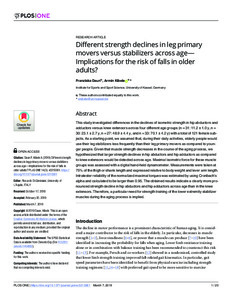Aufsatz

Different strength declines in leg primary movers versus stabilizers across age - Implications for the risk of falls in older adults?
Zusammenfassung
This study investigated differences in the declines of isometric strength in hip abductors and adductors versus knee extensors across four different age groups (n = 31: 11.2 ± 1.0 y, n = 30: 23.1 ± 2.7 y, n = 27: 48.9 ± 4.4 y, and n = 33: 70.1 ± 4.2 y) with a total of 121 female subjects. As a starting point, we assumed that, during their daily activities, elderly people would use their leg stabilizers less frequently than their leg primary movers as compared to younger people. Given that muscle strength decreases in the course of the aging process, we hypothesized that larger strength declines in hip abductors and hip adductors as compared to knee extensors would be detected across age. Maximal isometric force for these muscle groups was assessed with a digital hand-held dynamometer. Measurements were taken at 75% of the thigh or shank length and expressed relative to body weight and lever arm length. Intratester reliability of the normalized maximal torques was estimated by using Cronbach’s alpha and calculated to be larger than 0.95. The obtained results indicate a clearly more pronounced strength decline in hip abductors and hip adductors across age than in the knee extensors. Therefore, a particular need for strength training of the lower extremity stabilizer muscles during the aging process is implied.
Zitierform
In: PLoS ONE 14 / 3 (2019-03-07) , S. e0213361 ; ISSN: 1932-6203Förderhinweis
Gefördert durch den Publikationsfonds der Universität KasselZitieren
@article{doi:10.17170/kobra-20190520491,
author={Daun, Franziska and Kibele, Armin},
title={Different strength declines in leg primary movers versus stabilizers across age - Implications for the risk of falls in older adults?},
journal={PLoS ONE},
year={2019}
}
0500 Oax 0501 Text $btxt$2rdacontent 0502 Computermedien $bc$2rdacarrier 1100 2019$n2019 1500 1/eng 2050 ##0##http://hdl.handle.net/123456789/11249 3000 Daun, Franziska 3010 Kibele, Armin 4000 Different strength declines in leg primary movers versus stabilizers across age - Implications for the risk of falls in older adults? / Daun, Franziska 4030 4060 Online-Ressource 4085 ##0##=u http://nbn-resolving.de/http://hdl.handle.net/123456789/11249=x R 4204 \$dAufsatz 4170 7136 ##0##http://hdl.handle.net/123456789/11249
<resource xsi:schemaLocation="http://datacite.org/schema/kernel-2.2 http://schema.datacite.org/meta/kernel-2.2/metadata.xsd"> 2019-05-22T06:14:27Z 2019-05-22T06:14:27Z 2019-03-07 doi:10.17170/kobra-20190520491 http://hdl.handle.net/123456789/11249 Gefördert durch den Publikationsfonds der Universität Kassel eng Urheberrechtlich geschützt https://rightsstatements.org/page/InC/1.0/ 796 Different strength declines in leg primary movers versus stabilizers across age - Implications for the risk of falls in older adults? Aufsatz This study investigated differences in the declines of isometric strength in hip abductors and adductors versus knee extensors across four different age groups (n = 31: 11.2 ± 1.0 y, n = 30: 23.1 ± 2.7 y, n = 27: 48.9 ± 4.4 y, and n = 33: 70.1 ± 4.2 y) with a total of 121 female subjects. As a starting point, we assumed that, during their daily activities, elderly people would use their leg stabilizers less frequently than their leg primary movers as compared to younger people. Given that muscle strength decreases in the course of the aging process, we hypothesized that larger strength declines in hip abductors and hip adductors as compared to knee extensors would be detected across age. Maximal isometric force for these muscle groups was assessed with a digital hand-held dynamometer. Measurements were taken at 75% of the thigh or shank length and expressed relative to body weight and lever arm length. Intratester reliability of the normalized maximal torques was estimated by using Cronbach’s alpha and calculated to be larger than 0.95. The obtained results indicate a clearly more pronounced strength decline in hip abductors and hip adductors across age than in the knee extensors. Therefore, a particular need for strength training of the lower extremity stabilizer muscles during the aging process is implied. open access Daun, Franziska Kibele, Armin doi:10.1371/journal.pone.0213361 publishedVersion ISSN: 1932-6203 3 PLoS ONE e0213361 14 </resource>
Die folgenden Lizenzbestimmungen sind mit dieser Ressource verbunden:
Urheberrechtlich geschützt

